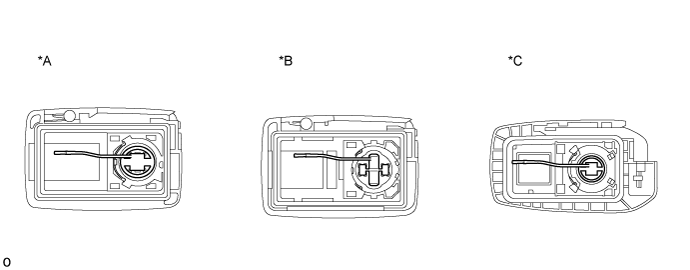Door Control Transmitter (W/ Entry And Start System) -- Inspection |
| 1. INSPECT TRANSMITTER BATTERY |
Inspect the operation of the transmitter.
- NOTICE:
- When replacing the transmitter battery, before starting work, remove static electricity that has built up in the body by touching, for example, the vehicle to prevent the electrical transmitter from being damaged.
Remove the battery (lithium battery) from the transmitter (Click here).
Install a new or normal battery (lithium battery).

Text in Illustration *A for Type A *B for Type B *C for Type C - - - HINT:
- If a new or normal battery is not available, first connect 2 new 1.5 V batteries in series. Then connect leads to the batteries and apply 3 V to the transmitter as shown in the illustration.
From outside the vehicle, approximately 1 m (3.28 ft) away from the driver side outside door handle, test the transmitter by pointing its key plate at the vehicle and pressing a transmitter switch, or while carrying the transmitter, touch the inside of the handle and pull it.
- OK:
- The door lock can be operated via the transmitter.
- The LED comes on more than once.
- HINT:
- The operational area differs depending on the user, the way the transmitter is held, and the location.
- The weak electric waves from the transmitter may be affected if the area has strong electric waves or noise. The transmitter operational area may be shortened or the transmitter may not function.
Inspect the battery capacity.
- NOTICE:
- When replacing the transmitter battery, before starting work, remove static electricity that has built up in the body by touching, for example, the vehicle to prevent the electrical transmitter from being damaged.

Text in Illustration *A for Type A *B for Type B *C for Type C - - Remove the battery from the electrical key transmitter that does not operate. Attach a lead wire (0.6 mm (0.0236 in.) in diameter or less including wire sheath) with tape or equivalent to the negative terminal (Click here).
- NOTICE:
- Do not wrap the lead wire around a terminal, wedge it between terminals, or solder it. A terminal may be deformed or damaged, and the battery will not be able to be installed correctly.
Carefully extend the lead wire from the position shown in the illustration and install the previously removed transmitter battery.
Check the transmitter battery voltage.

Text in Illustration *A for Type A (lithium battery: CR1632) *B for Type B (lithium battery: CR1632) *C for Type C (lithium battery: CR2032) - - - HINT:
- When measuring the battery voltage, bring the electrical key transmitter within the smart access system operating range and the lock switch of a door handle to perform the measurement. For the smart access system operating range, refer to System Description (Click here).
- Standard Voltage:
Tester Connection Condition Specified Condition Transmitter battery positive (+) - Transmitter battery negative (-) Engine switch off, all doors closed and lock switch pushed 2.5 to 3.2 V (Refer to waveform)